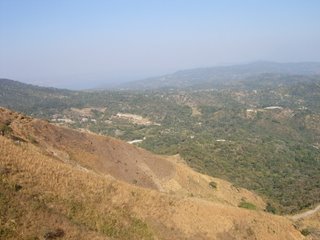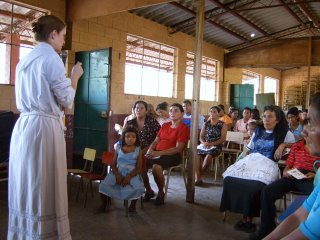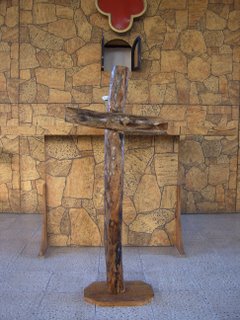Monday, April 24, 2006
Sunday, April 16, 2006
Saturday, April 15, 2006
Thursday, April 13, 2006
What my hands did on Maundy Thursday
Embraced the shoulders of friends whose mother/grandmother had past away
Held the Bishop's bible as I read the gospel at her funeral
Kneaded communion bread
Grasped a broom handle and swept the church and front steps
Washed and dried feet-- baby feet, children's feet, old women's feet, feet that had survived massacres, feet that had fled from fighting, sturdy women's and men's feet, my husband's feet
Offered bread and wine to friends-- the body and blood of Christ
Held Vince's hand as we fell asleep
Wednesday, April 12, 2006
A Holy Week Reflection on Suffering
 View from Puerto del Diablo, a notorious body dump during the war
View from Puerto del Diablo, a notorious body dump during the war
Today, Miércoles Santo (Holy Wednesday) I lead a mini-retreat on “Following Christ in his Passion and Resurrection.” The retreat didn’t go precisely how I had planned, but I really got something out of it, and I think the other eight adults present did as well. I thought I would share a few of the reflections that came out of the group with you.
We read Mark 8:34-37, and asked what it might mean when Jesus says, “Those who try to preserve their lives will lose them, and those who sacrifice their lives for my sake and for the sake of the Gospel will save them.” First, we tried to come up with examples of people who try to preserve their lives, but in the end, not only die, as we all do, but end up killing their interior lives as well. The immediate example that came to mind was the very wealthy. In this country anyone with money has a ten foot high wall, usually with barbed wire on top, around their home. We talked about the fact that walling out the world might help give a sense of security, but that it also cuts one off from the reality of the world outside, and in the end will not protect. We talked also about people who turned others in to the death squads during the war. Romana spoke right up, ¨Yes, if someone had an enemy in the town, that was it, because they´d turn them into the death squads, and they´d be killed. And then that person felt all important.¨ ¨But their soul?” I replied. When we make decisions to preserve ourselves at the cost of others—big or small—these decisions kill a piece of our soul. That is how some individuals in this country arrived at the point where they could do unspeakable things to other human beings—those who committed atrocities were simply dead inside already.
We then looked at the other alternative—the option for life. What does it mean when Jesus says we must be ready to sacrifice our lives? Or when he says we must “deny ourselves”? We came up with a lot of different answers—literal examples like Oscar Romero and the Salvadoran martyrs who gave their lives in the struggle for justice, and people more recently who have been willing to risk and sacrifice their lives to save others during the disasters. But how do we give away our lives on a daily basis? What if we were to hold our lives, our time, our possessions, our comforts, our pride, our resentments, etc, more loosely, to let go of our death-grip on them? What if we were to take the words of Jesus, “Father, into your hands I commend my spirit,” as a daily motto, keeping in mind our mortality and handing over our lives to God, and remembering that everything we have and are, and our very breath from moment to moment, come from God? What if we were to give thanks to God for everything, even the things we don’t like?
Then we came to the part about the cross. I have the immense privilege at the moment of auditing a class taught by the liberation theologian Jon Sobrino, who talks about “carrying/bearing reality”—“cargando con la realidad,” as a necessary requisite for the redemption of reality, on the pattern of Jesus. Henri Nouwen talks in his book on the Stations of the Cross about this kind of solidarity—as being truly present to the reality of the poor and those who suffer injustice. He goes one step further, however, in saying that if we are unable to be present with and carry our own crosses, the suffering which is particular to our selves and situations, our own reality, then we will be unable to bear and be in solidarity with the reality of the world. In his characteristic vulnerability Nouwen names his own crosses—loneliness, depression. So our little group spent fifteen minutes writing down answers to these questions: (1) What are your crosses? (2) How is Jesus calling you to follow him with these crosses?
When we did this reflection, something quite remarkable happened. I thought we would all be very depressed after writing about our crosses, and that we would need a whole discussion about resurrection, which I had prepared. But as we shared about the experience of writing about the deepest sufferings that afflict us in our daily lives, the mood was quite joyful! I had found that as I wrote about my crosses, and what I thought Jesus would want me to do about them (most of which had to do with a change of attitude or approach on my part), the weight of them grew less and less. If I approach these crosses as Jesus is asking me to, it turns out, I will actually suffer less pain in my daily life! Jesus doesn’t want me to suffer! Others had the same experience, and shared about how much it helped to write, how wonderful it is to know that we don’t have to carry these things on our own, that God is there wanting to help us, if we’ll allow it. We no longer needed a discourse on resurrection. We had experienced a moment of it, right then and there. We had experienced that entering through the narrow door of being truly present to our suffering and mortality, “carrying reality,” and we found life springing forth from those very crosses, not only eternal life, but the abundant life that Christ wants for us here and now. For the first time in my life I think I truly understood why Jesus asks us to “carry our crosses,” and follow him, and truly believed him when he says, “My yoke is easy, and my burden is light.” It’s not Easter yet, but this merits an ¡Aleluia!
Tuesday, April 11, 2006
Holy Tuesday Children´s Retreat
 We had a fun (and slightly chaotic!) time Holy Tuesday with about twenty children from the parish, taking a walk through the events of Holy Week. They had experienced Palm Sunday dramatizing the triumphal entry, so we started with Jesus in the Temple at the entrance to the church, where I charged a ¨temple tax¨ for the kids to enter the church, and ¨Jesus¨ did away with that! Subsequent stations included Judas betraying Jesus, the Last Supper with communion (with sweet bread and orange juice) and foot washing, the garden of Gethsemane, Jesus before Pilate (the kids washed their hands and felt a crown of thorns). Then we followed Jesus as (s)he carried the cross, stumbling. We all helped carry the heavy cross, and found it was much easier when we all helped. Real nails were driven into the cross, as we recited the seven last words of Jesus, and then we returned to the church to ¨bury¨Jesus (the crown of thorns and ¨Jesus¨ sign wrapped in a white sheet) behind the altar. After talking about what death is like, and what Jesus´death means, we told the resurrecction story, complete with the ¨Aleluia¨ sign the kids had made. Thanks so much to +Steve Kelsey for sharing his Children's Good Friday service with me!
We had a fun (and slightly chaotic!) time Holy Tuesday with about twenty children from the parish, taking a walk through the events of Holy Week. They had experienced Palm Sunday dramatizing the triumphal entry, so we started with Jesus in the Temple at the entrance to the church, where I charged a ¨temple tax¨ for the kids to enter the church, and ¨Jesus¨ did away with that! Subsequent stations included Judas betraying Jesus, the Last Supper with communion (with sweet bread and orange juice) and foot washing, the garden of Gethsemane, Jesus before Pilate (the kids washed their hands and felt a crown of thorns). Then we followed Jesus as (s)he carried the cross, stumbling. We all helped carry the heavy cross, and found it was much easier when we all helped. Real nails were driven into the cross, as we recited the seven last words of Jesus, and then we returned to the church to ¨bury¨Jesus (the crown of thorns and ¨Jesus¨ sign wrapped in a white sheet) behind the altar. After talking about what death is like, and what Jesus´death means, we told the resurrecction story, complete with the ¨Aleluia¨ sign the kids had made. Thanks so much to +Steve Kelsey for sharing his Children's Good Friday service with me!


Sunday, April 09, 2006
Domingo de ramos
 Gathering and beginning the Palm Sunday procession at the Mercadito (little market) in Amatepec
Gathering and beginning the Palm Sunday procession at the Mercadito (little market) in Amatepec
 Niña Romana passes out the palms and crosses to those in the procession and to nearby people in the neighborhood
Niña Romana passes out the palms and crosses to those in the procession and to nearby people in the neighborhood
Processing down Calle de los Abetos to the church
Jesus hangs on while attempting to peer over his donkey's massive ears. A very suave animal the kids created that could even do wheelies.











